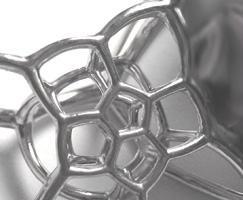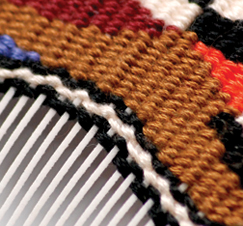Blowing bubbles
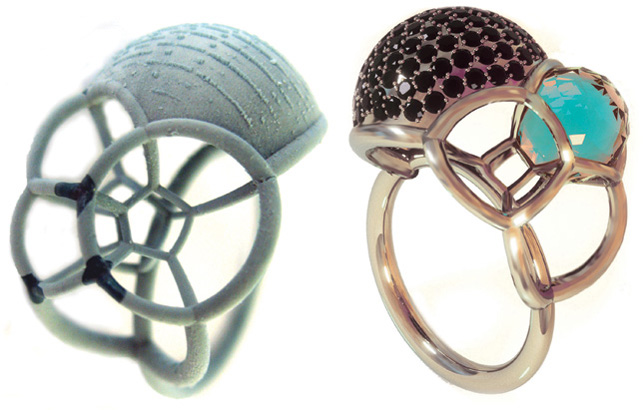
Lynne MacLachlan uses generative design software to mimic the bubble and foam structures in her jewellery and small product design
Inspired by nature, science and specifically soap bubbles, Lynne MacLachlan has taken 3D CAD traditionally used in architecture to produce stunning generative designs.
“Most of my work has been inspired by nature in some way, and more specifically the patterns found in nature,” explains Lynne. “These patterns are efficient yet beautiful solutions to the challenges of existence in a world governed by the laws of science, shaped by physics and chemistry.”
Lynne’s work has looked at different aspects of organic growth and the ways of replicating it through digital design.
Becoming fascinated with the structures of soap bubbles resting on skin, the concept was to “freeze the moment in precious metal”.
“My aim was to mimic bubble and foam structures using generative techniques – software that generates forms in a controlled manner,” says Lynne. “This approach has recently been explored most widely in architecture.
“Generative art and design is a relatively new field and I found this controlled randomness to be an exciting and fertile ground for design development.
“I wanted to apply these ideas to jewellery and small product design, something that has not been widely done yet.”
Using the software Jenn3D, Lynne was able to create a form through the fluid manipulation of mathematical forms.
Once happy with the result it could be transferred into Rhino and used as a guide to build a NURBS model, manipulated to fit the part of the body the piece was to adorn.
From there, renders could be produced in Maxwell Render, before taking the pieces into production using rapid prototyping.
“Solidscape moulds are used to create the actual pieces: each one is individually rapid prototyped and the cast into precious metals,” says Lynne.
“The forms are very complex and require hours of skilled hand finishing and polishing to create the final pieces,” concludes Lynne, proving that not everything is left down to science.
Ancient tradition meets 21st century tech
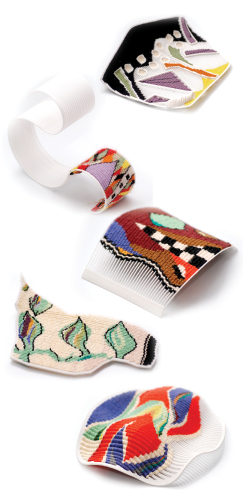
Updating a traditional art form is nothing new, but modernising the process to produce new dimensions and scales while still retaining an individual touch takes something special.
The diminishing practise of tapestry weaving has been given a conceptual rethink by designer Chloë McCormick, who was looking for new ways in which the traditional weaving technique could be used in her collection ‘Warped Tapestry’.
“I wanted to bring hand woven tapestry together with new technologies and materials to create 3D objects that could be used in different ways and in different scales, for example as jewellery or even furniture!” says Chloë.
“The product was designed through my own drawings of interior spaces, something that really interests me. I took these drawings and played with the shapes I created which were then drawn up in a 3D modelling program.”
Rhino was used to model the 3D warp structures for the weave and these were then built in an EOS P100 laser sintering machine.
“Rapid prototyping helped to develop an understanding for scale and how far I could take this object,” explains Chloë.
Once the frame is built then the piece can be woven onto it. The process relies on being able to produce a 3D prototype with an extremely fine frame to weave through, but one that is also strong enough.
“The product is bespoke, a one off and hand woven tapestry which is something that is rapidly diminishing and brought together by technology in the frame or ‘warp’.
The traditional weaving process remains the same, and depending on the scale, anything can be woven through the warp, whether it’s intricate jewellery, or (production methods allowing) full-scale furniture.
“You are never quite sure how something will turn out once it’s made, so I was forever taking risks and wondering if it would be what I imagined.”
Thanks to some elaborate design and some clever technology it would appear the gamble was well worth it.
It started with a kiss

London-based jewellery designer Nicholas O’Donnell-Hoare uses 3D scanning and photography to produce his innovative nylon creations
This necklace and ring are two parts of a commission to show the possibilities of working with 3D to produce something untouched by hand that represents the body aesthetically.
Produced using 3D photography, 3D printing and designing in 3D CAD, ‘Kissed’ is designed by London-based jewellery designer Nicholas O’Donnell-Hoare.
The concept was to work with 3D scanning and photography to produce something completely different for the prestigious International Jewellery London show.
“The idea was batted around that a collection of jewellery could be made with the use of 3D photography only we didn’t know how,” says Nicholas. “We knew that if we were able to manipulate one of these pictures we could probably warp it into a beautiful necklace, bracelet or ring.
Beginning by playing around with the 3D cameras at dental and facial scanning specialist, Cavendish Imaging, the images were then warped, extruded and sized in Rhino.
After about thirty attempts they had a product that was ready for printing, and the Rhino model was sent to an EOS P100 to produce the piece in full.
“We wanted to have a complete product finished by machine and not by hand so this type of machine was the obvious choice,” explains Nicholas. “Every part of the collection is made in one piece of nylon in one print including the chain. It means there are no joins, seams or fault lines but it does mean you need quite a lot of preparation and understand what the machines can and cannot do.”
“As we knew the product was never going to be cast or have to be made by hand we could use as much detail as we liked, knowing that the sizes, colour, material, finish were going to be just as we wanted.
“It gave the platform for us to make almost anything we dreamed.”
nodh.co.uk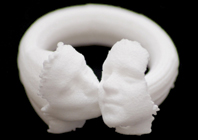
Innovative uses for technology being used in a new generation of objets d’art
Default


